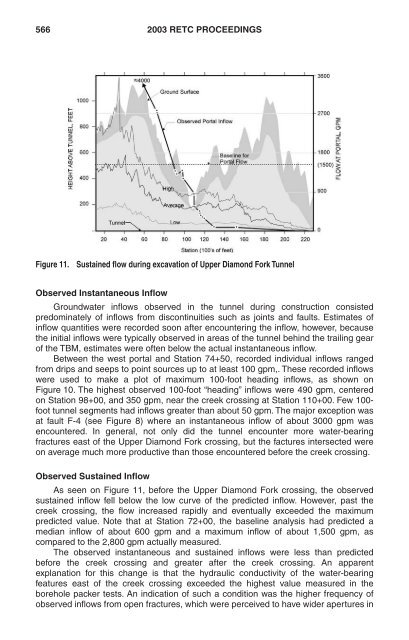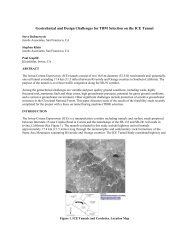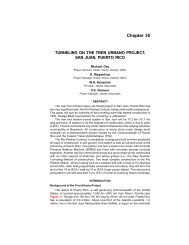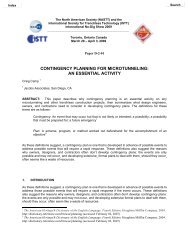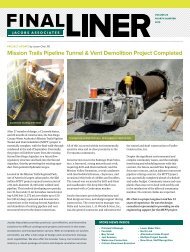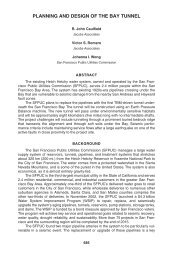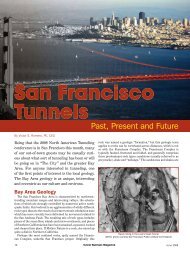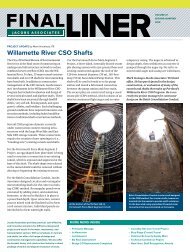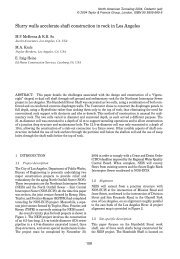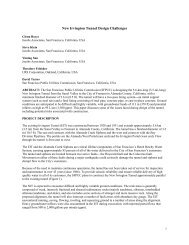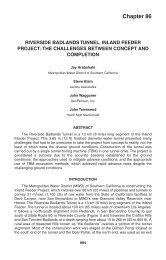Predicted and Observed Groundwater Inflows into Two Rock Tunnels
Predicted and Observed Groundwater Inflows into Two Rock Tunnels
Predicted and Observed Groundwater Inflows into Two Rock Tunnels
You also want an ePaper? Increase the reach of your titles
YUMPU automatically turns print PDFs into web optimized ePapers that Google loves.
566 2003 RETC PROCEEDINGS<br />
Figure 11.<br />
Sustained flow during excavation of Upper Diamond Fork Tunnel<br />
<strong>Observed</strong> Instantaneous Inflow<br />
<strong>Groundwater</strong> inflows observed in the tunnel during construction consisted<br />
predominately of inflows from discontinuities such as joints <strong>and</strong> faults. Estimates of<br />
inflow quantities were recorded soon after encountering the inflow, however, because<br />
the initial inflows were typically observed in areas of the tunnel behind the trailing gear<br />
of the TBM, estimates were often below the actual instantaneous inflow.<br />
Between the west portal <strong>and</strong> Station 74+50, recorded individual inflows ranged<br />
from drips <strong>and</strong> seeps to point sources up to at least 100 gpm,. These recorded inflows<br />
were used to make a plot of maximum 100-foot heading inflows, as shown on<br />
Figure 10. The highest observed 100-foot “heading” inflows were 490 gpm, centered<br />
on Station 98+00, <strong>and</strong> 350 gpm, near the creek crossing at Station 110+00. Few 100-<br />
foot tunnel segments had inflows greater than about 50 gpm. The major exception was<br />
at fault F-4 (see Figure 8) where an instantaneous inflow of about 3000 gpm was<br />
encountered. In general, not only did the tunnel encounter more water-bearing<br />
fractures east of the Upper Diamond Fork crossing, but the factures intersected were<br />
on average much more productive than those encountered before the creek crossing.<br />
<strong>Observed</strong> Sustained Inflow<br />
As seen on Figure 11, before the Upper Diamond Fork crossing, the observed<br />
sustained inflow fell below the low curve of the predicted inflow. However, past the<br />
creek crossing, the flow increased rapidly <strong>and</strong> eventually exceeded the maximum<br />
predicted value. Note that at Station 72+00, the baseline analysis had predicted a<br />
median inflow of about 600 gpm <strong>and</strong> a maximum inflow of about 1,500 gpm, as<br />
compared to the 2,800 gpm actually measured.<br />
The observed instantaneous <strong>and</strong> sustained inflows were less than predicted<br />
before the creek crossing <strong>and</strong> greater after the creek crossing. An apparent<br />
explanation for this change is that the hydraulic conductivity of the water-bearing<br />
features east of the creek crossing exceeded the highest value measured in the<br />
borehole packer tests. An indication of such a condition was the higher frequency of<br />
observed inflows from open fractures, which were perceived to have wider apertures in


